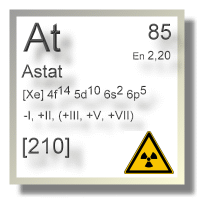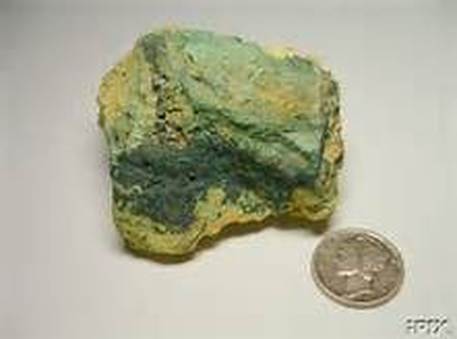

Most of the physical properties of astatine have been estimated (by interpolation or extrapolation), using theoretically or empirically derived methods. Astatine is usually classified as either a nonmetal or a metalloid metal formation has also been predicted. It remains to be seen if, with sufficient cooling, a macroscopic quantity of astatine could be deposited as a thin film.

A visible piece of astatine would immediately vaporize itself because of the heat generated by its intense radioactivity. Research is limited by its short half-life, which prevents the creation of weighable quantities. The bulk properties of astatine are not known with any certainty. Of the first 101 elements in the periodic table, only francium is less stable, and all the astatine isotopes more stable than francium are in any case synthetic and do not occur in nature. Most of its isotopes are very unstable, with half-lives of one second or less. Neither the most stable isotope astatine-210, nor the medically useful astatine-211, occur naturally they can only be produced synthetically, usually by bombarding bismuth-209 with alpha particles.Īstatine is an extremely radioactive element all its isotopes have half-lives of 8.1 hours or less, decaying into other astatine isotopes, bismuth, polonium, or radon. Four isotopes of astatine were subsequently found to be naturally occurring, although much less than one gram is present at any given time in the Earth's crust. Segrè at the University of California, Berkeley, who named it from the Ancient Greek ἄστατος ( astatos) 'unstable'. Corson, Kenneth Ross MacKenzie, and Emilio G. The first synthesis of the element was in 1940 by Dale R.

Chemically, several anionic species of astatine are known and most of its compounds resemble those of iodine, but it also sometimes displays metallic characteristics and shows some similarities to silver. Astatine is likely to have a dark or lustrous appearance and may be a semiconductor or possibly a metal. However, astatine also falls roughly along the dividing line between metals and nonmetals, and some metallic behavior has also been observed and predicted for it. Many of them have been estimated from the element's position on the periodic table as a heavier analog of iodine, and a member of the halogens (the group of elements including fluorine, chlorine, bromine, and iodine). The bulk properties of astatine are not known with certainty. A sample of the pure element has never been assembled, because any macroscopic specimen would be immediately vaporized by the heat of its own radioactivity. All of astatine's isotopes are short-lived the most stable is astatine-210, with a half-life of 8.1 hours. It is the rarest naturally occurring element in the Earth's crust, occurring only as the decay product of various heavier elements. Astatine is a chemical element with the symbol At and atomic number 85.


 0 kommentar(er)
0 kommentar(er)
